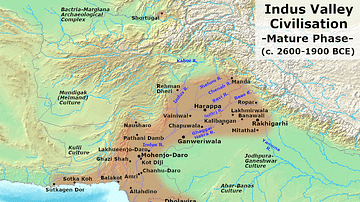Illustration
A map illustrating the evolution of the cultures on the northern Indian subcontinent with the arrival of the Aryan nomads during the late Bronze Age and early Iron Age known as the Vedic age (c. 1500 – c. 500 BCE), when the Vedic literature was composed, between the end of the Indus Valley Civilisation and the establishment of the Mahajanapadas ("Great Realms") on the central Indo-Gangetic Plain c. 500 BCE.
About the Author
Cite This Work
APA Style
Netchev, S. (2021, August 31). India in the Vedic Age, 1500 BCE-500 BCE. World History Encyclopedia. Retrieved from https://www.worldhistory.org/image/14540/india-in-the-vedic-age-1500-bce-500-bce/
Chicago Style
Netchev, Simeon. "India in the Vedic Age, 1500 BCE-500 BCE." World History Encyclopedia. Last modified August 31, 2021. https://www.worldhistory.org/image/14540/india-in-the-vedic-age-1500-bce-500-bce/.
MLA Style
Netchev, Simeon. "India in the Vedic Age, 1500 BCE-500 BCE." World History Encyclopedia. World History Encyclopedia, 31 Aug 2021, https://www.worldhistory.org/image/14540/india-in-the-vedic-age-1500-bce-500-bce/. Web. 02 May 2025.








